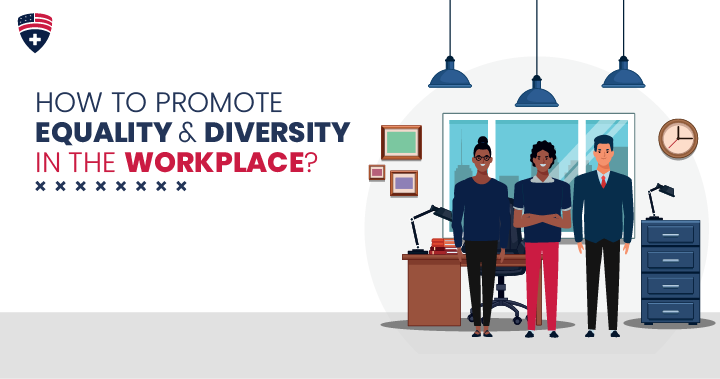
How to Promote Equality and Diversity in the Workplace?
In today’s diverse world, it is important to support equality and diversity in the workplace. Making sure everyone feels valued, respected, and in charge is important for success, new ideas, and working together.
But the question is, how to promote equality and diversity in the workplace? To create equality in the workplace, you need to make sure that all employees are treated fairly and have the same chances to succeed, no matter who they are or where they come from.
American Healthcare Compliance created the Sexual Harassment in the Workplace course to help employees spot discrimination, report it, and stay away from it.
Let us look at some creative and simple ways to make the workplace a place where everyone feels welcome.
Understanding Equality and Diversity in the Workplace
Workplace Equality at work means being fair to all employees and giving everyone the same chances, no matter their race, gender, age, or background.
One way to do this is to create a space where discrimination is not allowed and people are valued for their skills and contributions rather than their characters.
Diversity means recognizing that everyone is unique, no matter their race, ethnicity, gender, sexual orientation, age, religion, disability, or anything else.
That each person brings unique thoughts, experiences, and abilities to the job.
This helps the company grow and promotes fresh ideas and creativity.
How to Encourage Equality and Diversity in the Workplace?
Educate and Train
Give all of your employees, from entry-level workers to top executives, full training on diversity, inclusion, and unconscious bias. This education helps people become more aware, fight stereotypes, and understand each other better as a team.
Lead by Example
The culture of the workplace is largely set by the people in charge. Through their actions, policies, and the way they make decisions, leaders should show that they care about equality and diversity.
Create Diverse Hiring Practices
Make sure that the way you hire people is open to everyone and does not show bias. Use diverse hiring panels, blind resume screening, and go out of your way to find people from groups that are not well-represented.
Encourage Inclusive Policies
Make sure that your company’s policies are up-to-date and support equality and diversity by reviewing and updating them. This includes rules about hiring, promoting, paying, and harassing people. Make sure that all of your employees understand these rules.
Provide Equal Opportunities
Give all employees, no matter what their background is, the same chances to move up in their careers, get training, and grow. Help underrepresented groups grow by setting up mentorship programmers and networking events.
Encourage Open Dialogue
Make sure that employees feel like they can talk about diversity issues in an open and polite way. Ask for feedback and ideas on how to make things better, and then do what needs to be done to address concerns.
Celebrate Differences
Recognize and celebrate the diverse backgrounds, experiences, and perspectives of your employees. Set up heritage months, cultural events, and campaigns to raise awareness about diversity to help people understand and appreciate each other.
Support Employee Resource Groups
Set up and support Employee Resource Groups (ERGs) so that workers from all walks of life can connect, talk about their experiences, and ask for changes at work.
Work-Life Balance
Make sure that your company’s policies and flexible work arrangements are family-friendly and meet the needs of all of your employees. This includes working from home, setting your own hours, parental leave, and help for carers.
Track and Measure Progress
To see how well your diversity and inclusion efforts are working, you should regularly check in on them and evaluate them. Find out about diversity metrics like employee satisfaction, retention rates, and the number of people who are represented. Then, use this data to help you plan your next steps.
How to Promote Gender Equality in the Workplace
- Equal Pay: Make sure that men and women get paid the same for the same work.
- Diverse Leadership: Use mentorship programs to help women get into leadership positions.
- Flexible Work Arrangements: Give caregivers a range of options so they can do their jobs.
- Anti-Discrimination Training: Teach about gender bias and harassment to make people respect each other.
- Parental Leave Policies: Give both men and women the same number of days of parental leave.
- Gender-Diverse Hiring: To get a wide range of applicants, use strategies that are open to everyone.
- Employee Resource Groups: Set up ways for women to get help at work.
- Diversity Assessments: Check in on gender diversity efforts on a regular basis to see how things are going.
- Mentorship Programs: Give women the chance to be coached and matched with men.
- Lead by Example: Senior leaders should support efforts to make sure men and women have equal rights.
In conclusion, How to promote equality and diversity in the workplace?
It is important to support equality and diversity in the workplace so that everyone feels valued and respected.
Being a leader in a culture of equality and diversity means having clear rules that everyone can follow, giving everyone the same chances, and encouraging open communication.
For both men and women to feel more welcome and equal at work, it is also important to respect differences, support employee resource groups, put work-life balance first, and keep track of progress.
It is better for everyone at work when all of these things are done together.
FAQs
What is an example of equality and diversity in the workplace?
Equality and diversity in the workplace example:
- Men and women doing the same job and getting paid the same.
- People with disabilities not being able to do their job, for example, someone in a wheelchair does the same job as someone sitting in a chair.
What are the principles of equality and diversity?
Equality means giving everyone in your setting the same chances, no matter what their background is or how they live their life.
Diversity means valuing the things that make people unique and respecting their beliefs, cultures, ways of life, and values.
How do we practice fairness and equity in the workplace?
Make sure everyone is treated equally and fairly by making policies clear and easy for everyone to find.
These rules should be looked over and changed often to stay relevant and address new issues.
Giving employees ways to voice their concerns without fear of getting in trouble is a good way to encourage open communication.





